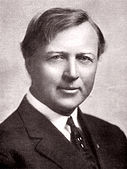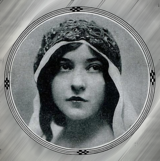|
The Yaqui
The Yaqui is a 1916 American silent Black and white Melodrama directed by Lloyd B. Carleton and starring Hobart Bosworth, Gretchen Lederer and Emory Johnson. The film depicts Yaqui Indians entrapped by nefarious elements into enslavement for a wealthy plantation owner. They struggle in captivity, eventually rebelling against their owner's oppression. The film was released on Mar 19, 1916 by Universal.[1][2] PlotFlores is a prosperous Mexican plantation owner, but he desperately needs workers for his plantation in the Yucatán Peninsula. General Martinez is an Indian-hating commander of a Mexican garrison in the northern district of Mexico. The garrison's headquarters are in the center of the Yaqui Indian nations. Since Flores has specific labor needs, he visits the northern district. Flores visits the garrison's headquarters and approaches General Martinez. He asks Martinez if he knows of any means of securing a contingent of Indians to work his fields. The two men draw up a plan which will mutually benefit both. The general's scheme is quite simple. He plans to attend a local Yaqui festival; then, during the celebration, he will publicly insult the Yaqui leaders' wife - Modesta. Martinez knows Tambor, the Yaqui leader, will not let the slight go unchallenged. At the festival of Santa Catalina, Martinez approaches Tambor's wife. He forcefully takes her in his arms and attempts to kiss her. Upon witnessing the general's insult to his wife, a mortified Tambor reacts angrily. He grabs his wife, and they return to their home. After a history of tribal abuse at the army's hands, this incident becomes the straw that broke the camel's back. The Yaqui rebels and start an insurrection. Unknowingly, the tribe has played right into Martinez's hands. Tambor's expected reaction provokes Martinez's military response. After the general suppresses the rebellion, he arrests the leaders, including Tambor. Martinez decides he must execute the chief conspirator of the uprising - Tambor. Someone in the crowd yells his avowed hatred of Tambor. He wants to handle the execution personally. Martinez gives him the gun, and the man shoots Tambor. The chief crumples into a pre-dug grave, and they cover the grave. But all is not as it seems. The executioner was part of a counter-plan. He had removed most of the powder in the cartridge, making the shot non-lethal, and Tambor was not hurt. Later, they exhumed his buried body and revived him.  Later on, the subjugated Yaqui tribesmen load trucks for their long trek south to the Flores plantation. Since we presume Tambor dead, his wife Modesta and his daughter Lucia are part of the Yaqui captives. The clever Tambor disguises himself and joins the caravan to the plantation. He will reunite with his family. After arriving at the plantation, Flores forces the Yaqui to work in the tropical sun for long hours. Shortly after their arrival, Tambor and his family reunite, but Tambor's daughter falls ill with a fever. Flores believes the work is more important than a single individual. They do not allow Tambor and Modesta to treat their daughter, and they must work in the fields instead. Because their daughter lacks any care, she dies. One night, Flores entices Modesta to come to the big house. After her arrival, he tries to rape her. Instead, then enduring this humiliation, Modesta stabs herself with her dagger. Tambor arrives at the big house, sees Modesta, overwhelmed with emotion. He pulls the knife from Modesta's' prone body and stabs Flores to death. Tambor gathers his tribe, and they head back to their homelands. Tabor plans to exact revenge from the repressive General Martinez. Meanwhile, we come to find out both Martinez and Lt. Hernandez, the Generals' second in command, is in love with a wealthy land owners' daughter. Ysobel is the daughter of Señor Esteban and Señora Esteban. Ysobel loves Hernandez, but her parents want her to marry the wealthier general. Both continue to vie for her affections. Lt. Hernandez is slowly becoming sympathetic to the plight of Yaquis. Tambor and his fellow Yaquis arrive in northern Mexico and gather their forces. General Martinez, sensing danger, places his troops on high alert. A sensational battle ensues. The Yaquis are victorious. Later there is a personal duel between Martinez and Tambor. After an exchange of gunfire, Martinez is lying dead on the ground. When the smoke settles, and everything returns to normal - Hernandez marries Ysobel. Cast
ProductionPre productionDevelopmentAccording to the book - The Universal Story, Carl Laemmle (c. 1867-1939) produced around 91 feature movies in 1916.[3] Casting
ThemesThe film's release was fortunate considering the events of 1916. The Yaqui Indian tribes were based both in Mexico and Arizona, with the lion's share located on the border's Mexican side. The Mexican Yaquis were engaged in a perpetual struggle with the Mexican army and the ruthless plantation owners. In the preceding decades, thousands of Yaquis had died. While these developments provided headlines for the American newspapers, the Yaqui Wars also kept the newspapers stoked. And if this wasn't enough, Pancho Villa continued to generate headlines by battling with the Mexican army and being chased by the American Army. ScreenplayIn 1913, author Dane Coolidge wrote a novel titled Land of Broken Promises. The novel was published in the 1913 November issue of Munsey's Magazine pages 313 - 404.[10] The magazine paid Coolidge $2,500 (equivalent to $62,056 in 2018) for publishing rights to the novel. In 1915, Coolidge expanded "The land of Broken Promises" into another novel titled - The Desert Trail. Coolidge's next movie success would be the story Rimrock Jones sold to Famous Players–Lasky and released under that title on January 21, 1918.[11] In addition to writing novels, Coolidge also tried to write movie scenarios. Over time, he would write four scenarios. A movie company accepted only one. The Yaqui, adapted from his novel "The Land of Broken Promises," was purchased by Universal for $400 (equivalent to $9,929 in 2018).[11] Universal bought the scenario to protect itself, because credit for the screen adaptation is given to well-known scenario writer - Olga Printzlau[12] FilmingThis exteriors for this film were shot in both Mexico and Tempe, Arizona. Universal felt shooting major parts in Mexico would lend an air of authenticity to this film. The post-publicity hype; both locations were only a "few hundred miles" west from Columbus, New Mexico.[13] Post productionStudiosThe theatrical release of this film totaled 5 reels.[a] Music M. Winkler is the musical arranger for this film. Max Winkler, often listed as M. Winkler or Moe Winkler, was not a musician or music composer. He was a salesman for band and orchestra music. Max worked for a publishing house in New York City called Carl Fischer Music. While working as a clerk, he amassed tremendous working knowledge of thousands of pieces of music. He could recall almost in an instant. He used this knowledge to create a list of music he believed provided the film's best background music. Once the compiled list was complete, he would publish these suggestions in the form of a "Cue Sheet." Theater musicians could follow the "Winkler Cue Sheet creating the perfect musical accompaniment for the film. There is no known copy of the Cue Sheet for the Yaqui.[16] Since Max was not a musician, his musical selections sometimes generated controversies. The criticism's basis was that only a true musician could develop a proper musical ambiance for a movie. There is an alternate musical cue sheet developed by Ernst Luz.[17] Release and receptionOfficial releaseThis film was officially released on July 13, 1916.[18][b] AdvertisingThis film carried Universal 's "Bluebird" brand, denoting a mid-range budget. Critical responseCritical reaction to the film mainly seemed favorable. In the March 16, 1916 issue of the Motion Picture News, Harvey F. Thew wrote:[19]
In the March 16, 1916 issue of the Variety, Jolo opined:[20]
In the March 18, 1916 issue of The Moving Picture World, Margaret MacDonald wrote:[21]
Preservation status
According to the Library of Congress, all known copies of this film are lost.[23][c] Gallery
Notes
References
External linksWikimedia Commons has media related to The Yaqui. |
||||||||||||||||||||||||||||||||||||||||||||||







